The Terracotta Soldiers in Xi’an are an exquisite example of realism in sculpture and are one of China’s archaeological crown jewels. Qin Shi Huang (259 BCE-210 BCE), the First Emperor of China, commissioned the funerary statues to accompany him into the afterlife for his protection and placed them within his 38 square mile mausoleum. Discovered in 1974 in the Lintong district by farmers digging a well, each of the roughly 8,000 life-sized soldiers and horses bears unique hair, face, and regalia down to the most minute details. Amazingly, China had never crafted anything like these before, so exactly how were the Terracotta Soldiers made?
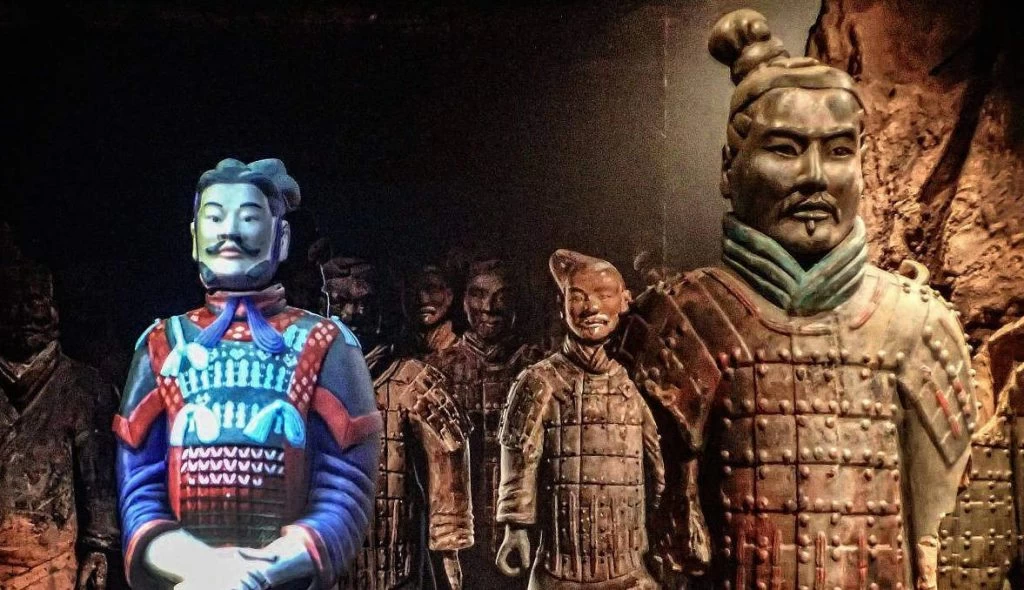
The funerary statues of the First Emperor were totally unique in China. How were the Terracotta Soldiers made? CC2.0 Mary Harrsch
A New Concept Emerges in China
The Terracotta Warriors are roughly six feet tall and weigh more than 600 pounds. This type of sculpture was completely novel in China and emerged abruptly. In the centuries before the First Emperor, changes in funerary practices had been occurring. Around 550 BCE, human sacrifices were commonplace. When a person of nobility died, the victims were placed in his mausoleum and, in this way, followed him into the afterlife.
If death was merely a continuation of life, as the ancient Chinese believed, then any ruler had to take his court, wives and concubines, staff, slaves, wealth, and possessions. In fact, evidence suggests that most subjects died willingly to accompany their dead leaders. (China’s Terracotta Warriors).
The Terracotta Army: Earthen Soldiers of China’s First Emperor
Chinese archaeologists discovered numerous graves with mass sacrifices of 100-200 victims in the Qin state. However, later, during the Warring States period (475 BCE-221 BCE), large-scale sacrifices became impractical, as manpower was necessary to fight the ongoing wars. As a result, instead of real humans, the use of small funerary statues was commonplace. But then in the mid-third-century BCE, Qin Shi Huang revolutionized the concept of funerary items in his own mausoleum.
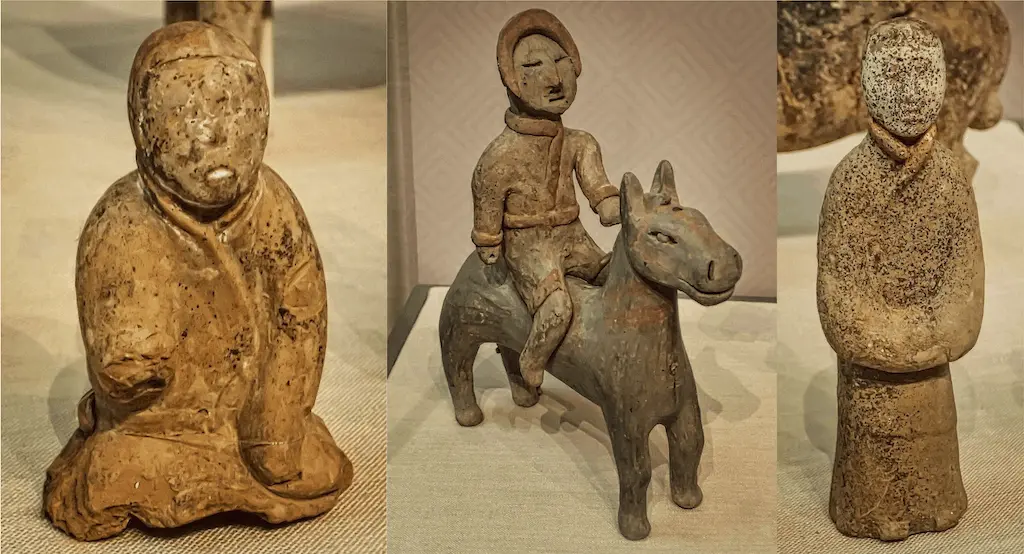
Third-century funerary figurines found in Qin tombs in Xi’an, Photos CC2.0 by Mary Harrsch, compiled.
See also: The Lavish Qin Shi Huang Tomb
Were the Terracotta Soldiers Influenced by Greeks?
What inspired the First Emperor to craft a full-sized clay army to place in his mausoleum in perfect battle formation complete with regalia, horses, and weapons? Nobody knows for certain, however, some experts have made convincing comparisons of Greek Hellenistic statues to the Terracotta Soldiers.
In fact, according to Seán and Colette Hemingway of the Metropolitan Museum of Art, Alexander the Great laid the foundation for Far East-West contact when he conquered lands into Central Asia and India before he died in 323 BCE. Then in the first half of the third century BCE after Alexander’s empire broke up, “an influential dynasty of Greek and Macedonian descent ruled over a vast kingdom that stretched from Bactria to the Far East.” During their reign, they erected many large statues.
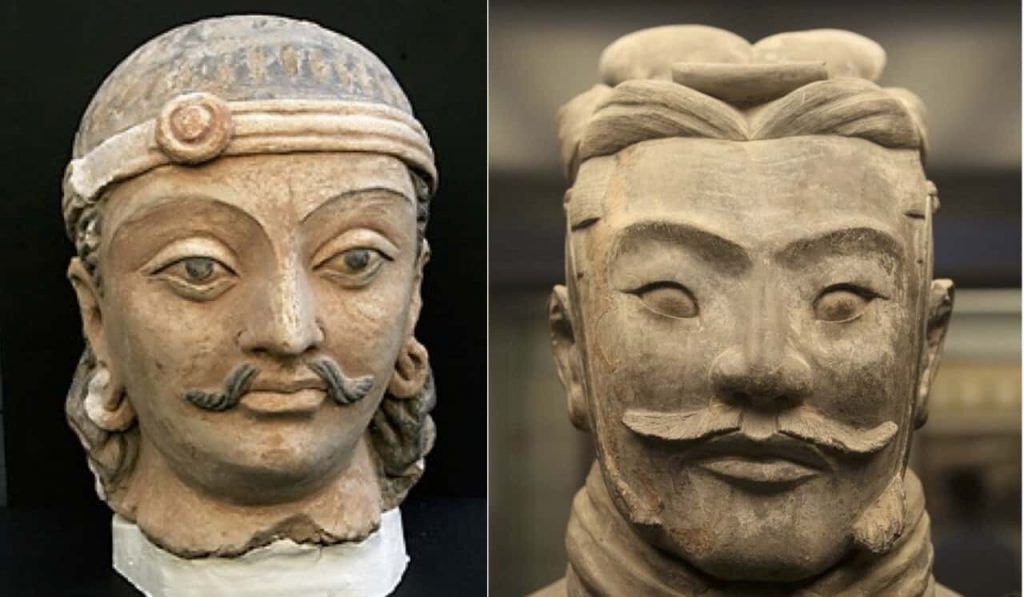
Bactrian stucco head of an Indian king, possibly King Ashoka, (L) and Terracotta Soldier (R) reveal some similarities.
In any case, the First Emperor had grandiose visions for his mausoleum, and he devoted an enormous amount of resources and manpower consisting of groups of men who became masters in the production of the Terracotta Soldiers.
Acquisition, Processing, Distribution
The first step in the process was the acquisition of the raw materials. In a joint effort between University College London’s Institute of Archaeology and archaeologists from Qin Shihuang’s Mausoleum Site Museum, Quinn et al. microscopically analyzed clay samples from the Terracotta Soldiers (also terracotta acrobats found within the mausoleum). They surmised that the raw materials for the statues came from local sources in the surrounding countryside. (Quinn et al.).
The next step involved processing, probably at a centralized facility. Analysis of clay samples shows a mixture of two types for the soldiers: a dark clay and a siltier lighter clay. Perhaps this combination may have served aesthetic or functional purposes. Additionally, those in charge of processing added sand temper to the clay for a few reasons. First, this would have reduced the “stickiness” of the clay and made it more moldable. Secondly, the sand made the clay more porous which allowed the sculptures to dry out before they went to the kiln. In the end, sand also resulted in a harder end-product. (Quinn et al.).
Once the processing unit fully prepared the clay, they distributed the materials to various workshops. These were most likely near the mausoleum. Stamps and inscriptions discovered in hidden locations of the statues indicated a royal government facility, Gong, which probably existed close to or in the capital. Additional engravings named some other places: Xianyang (the ancient capital) and three other cities that do not appear to have been extensively used (Li et al.). After they received the clay, sculptors began creating their masterpieces using two main techniques: clay coils and molds.
Roman Concrete: The Volcanic Material That Erected an Empire
Clay Coils
Clay-coiling is a method in which the clay is first pounded until it is soft. Then it is shaped into long rolls. For the bodies of the Terracotta Soldiers, the Qin artists layered the rolls of clay upward one coil upon another. By controlling the size of each coil, they were able to achieve a completely different body shape. Some soldiers have thin torsos, while others are rounder. After the sculptors finished their coils, they smoothed in and out and carved the fine details for the armor and folds of clothing.
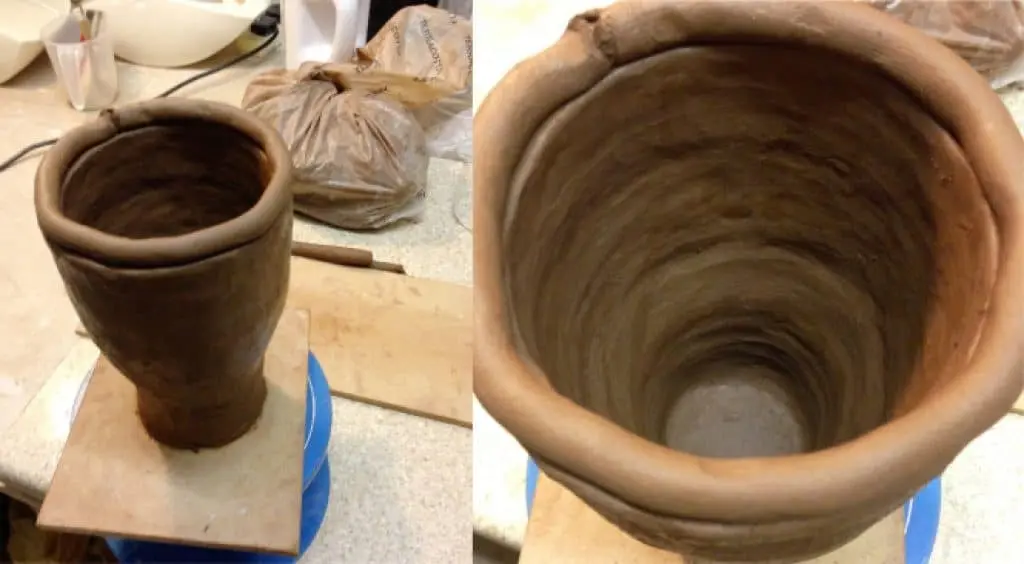
Example of the clay coiling method that was used to make the Terracotta Soldiers. Keyley Holderness Pottery
Sculptors also used the coil method for some warriors’ legs, which, today, remained hollow. Other legs, however, are solid clay. The feet were carved by hand. According to Li et al., some footboards were attached to the feet after firing, but a few others were made together with the feet in one piece. The sculpture of the arms occurred separately. While many show evidence of clay coils, thick sheets of clay formed other arms. Once they were shaped and designed, the arms were attached to the bodies.
[blockquote align=”none” author=”Li et al.”]The shape of warriors’ feet and lower legs exhibit certain typological regularities but seem to have been made by hand, with no clear-cut evidence as yet for the use of moulds.[/blockquote]
Because wet clay is very heavy, it can collapses under the weight of itself if too much coiling is done too quickly. Therefore, the bodies of the soldiers were created in small parts, and each part was allowed to dry over a number of days. The process was slow and tedious and took up to one month to make just one soldier.
Molds
In contrast to the clay-coil method, molds played a relatively small part. For body parts, such as heads, some ears, and hands, the craftsmen used various pre-fabricated molds. After they pressed the clay into the mold, they allowed the clay to harden just enough before connecting the piece.
Most of the Terracotta Soldiers’ heads show evidence of a two-part mold: one for the front and one for the back. The two pieces were connected behind the ear. Then the eyes, mouths, noses, and facial hair were hand-sculpted. Braids and hair-knots atop the head were probably molded. Conversely, a few heads appear to have had a mold for the face including the facial features, while the back portion of the head was hand-made. (Li et al.)
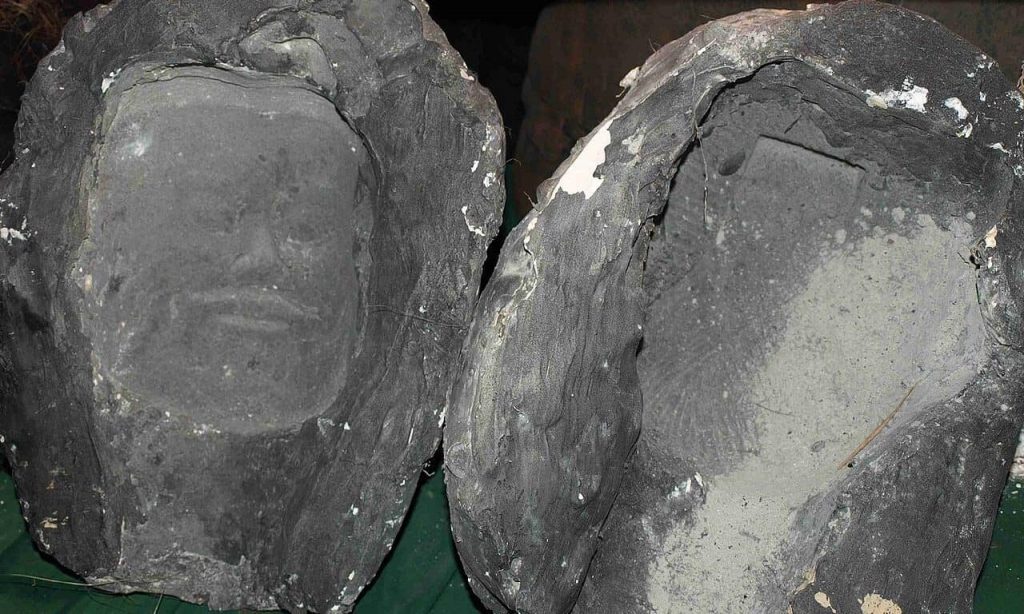
Photo of a head and face mold at a Terracotta Soldiers exhibition in Dijon, 2009. CC3.0 Prosopee.
Kiln Firing
Once the clay parts dried and stiffened sufficiently, according to petrographic analysis, they were kiln-fired. How and where this occurred is still a mystery, as no one has ever conclusively located the kiln. However, most experts surmise that it probably occurred very close to the final Terracotta Army pits. Additionally, some theories propose that the artists crafted and fired the soldiers in the same facility. As such, this would have alleviated the need to transport the extremely heavy, yet delicate, statues.
According to Quinn et al., during the construction phase of the Terracotta Museum, local farmers claimed to have come across the remains of kilns and terracotta fragments. Unfortunately, no investigations of the report ever took place.
On National Geographic’s documentary, “China’s Ghost Army,” Zhang Binruo, a modern-day terracotta soldier replica maker, proposed a theory. He thinks the Qin artists used cave houses that locals had dug into the mountainsides. This would have ameliorated the extreme temperature fluctuations between summer and winter, which was important because clay sculptures in progress cannot withstand very hot or very cold temperatures. In the Qin capital, winter temperatures could get down into the teens. During the summer, it could reach the upper eighties. Cave houses, however, would have maintained an ideal average temperature of about 70 degrees throughout the year. Additionally, workers could seal off the cave house and turn it into a kiln as needed, eliminating the need to move the statues.
Painting
After kiln firing, the warrior was ready for the final touch that brought him to life: color. The greyish Terracotta Warrior statues we see today did not look this way initially. They bore bright colors. Underneath their brilliant exteriors, artists applied a protective lacquer known as qi, which was very valuable but not easily obtainable.
Collectors ventured into the forests of lacquer trees and gathered the precious sap. However, they could only remove about ten grams without killing each tree. Some experts believe that each terracotta warrior may have required the sap of about 25 trees. For the entire army, they estimate up to 200,000 trees. As the base layer on the Terracotta Soldiers, the qi protected the underlying clay and prepared it for the layers of polychromatic paint that finished off each statue. (Nat Geo, “China’s Ghost Army”).
According to Rachel Brazil in her Chemistry World article, Colouring in the Past,
[blockquote align=”none” author=”Rachel Brazil”]Statues excavated more recently, where polychrome surfaces have been conserved, show vivid colours – red, violet, pink, white, blue and green – from a range of inorganic minerals. There is also evidence of synthetic blue and purple barium copper silicate pigments, the first synthetic blue used in China (from 700BCE to 220CE).[/blockquote]
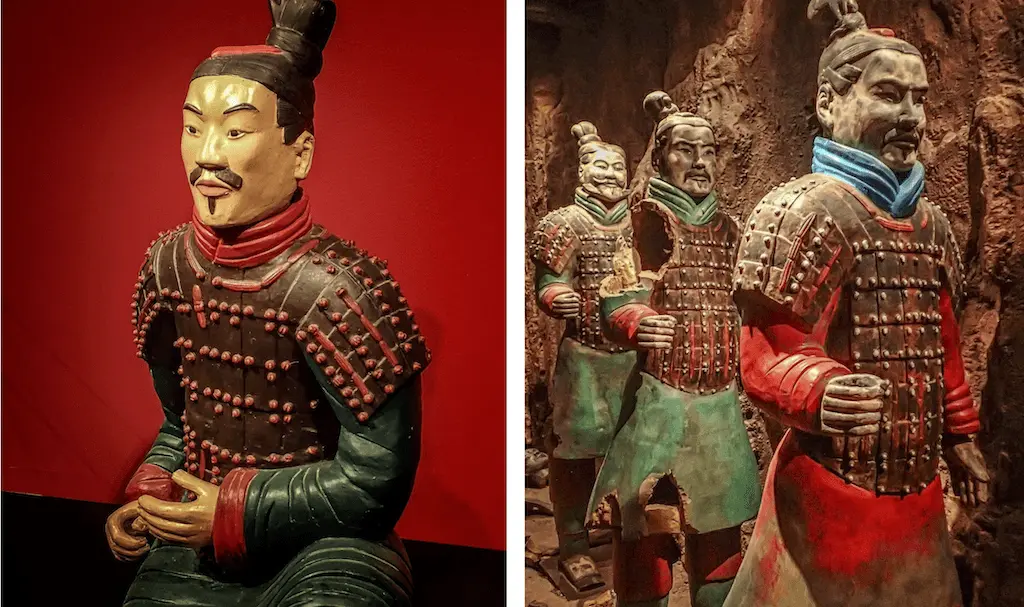
These replicas reveal some of the original colors of the Terracotta Soldiers. CC2.0 Mary Harrsch.
Degradation and Conservation of Colors
Unfortunately, after excavations, all the colors of the Terracotta Soldiers disappeared once the qi lacquer dried out. As long as the soldiers remained in the moist dirt, their colors stayed intact. However, once the open air-dried the lacquer, all of the original pigments chipped and flaked off the statue.
Without effective conservation techniques in place, excavations have slowed down in recent decades. However, Chinese scientists have been working closely with experts from the Technical University of Munich to produce methods that will preserve the delicate colors after excavation. In the future, the museum will hopefully display more terracotta soldiers with their original pigments.
The Sum of Tyranny and Brilliance
The First Emperor was a fearsome leader, and he would kill those who opposed or displeased him. However, he had another side. Experts believe that he possessed an unparalleled ability to organize large groups of men into highly structured enterprises. Qin Shi Huang standardized production, and his keen sense of specialization of labor allowed his men to hone their skills to mastery levels. In his heightened demonstration of tyranny and brilliance, the emperor achieved his lofty ambitions quickly.
Qin Shi Huang conquered and unified all of China. He created one system of writing, weights, and measures for all of his people. Additionally, the first version of the Great Wall, a super-highway linking the empire, and the largest mausoleum with thousands of realistic life-sized terracotta soldiers are all accomplishments of the First Emperor of China. Nearly 2,000 later, his legacy lives on.
References:
Brazil, Rachel. “Colouring in the past.” Chemistry World. May 8, 2017.
Hemingway, Colette, and Seàn Hemingway. “Art of the Hellenistic Age and the Hellenistic Tradition.” The Met. April 2007.
Li, Xiuxhen, Andrew Bevan, Marcos Martinón-Torres, Yin Xia, and Kun Zhao. “Marking Practices and the Making of the Qin Terracotta Army.” UCL. 2016.
Quinn, Patrick, Patrick, Yin Shia, Shangxin Zhang, and Xiuzhen Janice Li. “Building the Terracotta Army: Ceramic Craft Technology and Organisation of Production at Qin Shihuang’s Mausoleum Complex.” Academia. 2017.